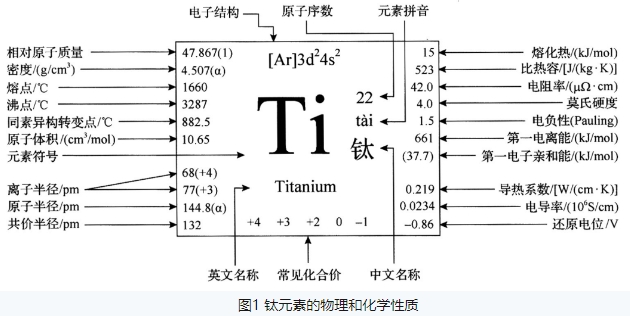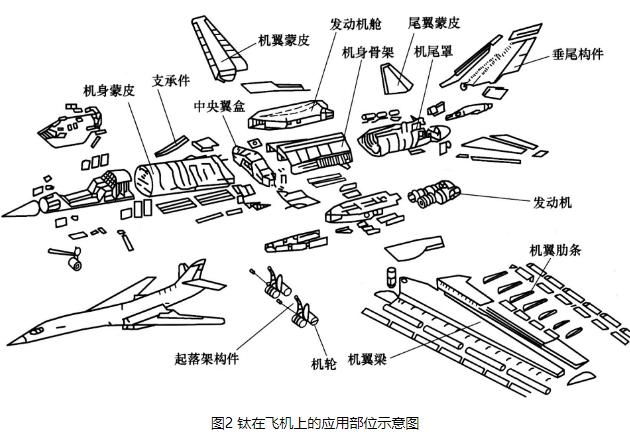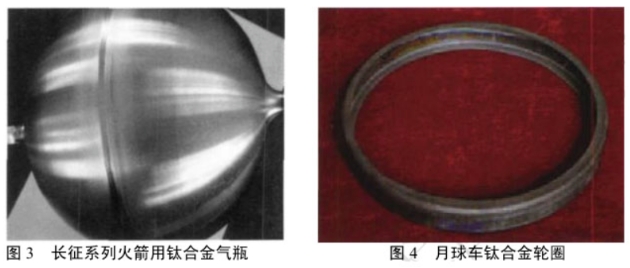1、 The source of titanium metal
Titanium metal was first discovered by an amateur mineralogist named Gregor in England in 1791. By 1795, German chemist Klaplus named this unknown metallic substance after the Greek god Titans, which is translated as "titanium" in Chinese and English.

Titanium is recognized as a non-toxic element worldwide, with high extraction and production costs and high prices. Due to a series of qualifications such as high and low temperature resistance, strong acid and alkali resistance, high strength, and low density, it has become a specialized material for NASA's rocket satellites and has also been applied in China's super projects such as the Yutu, J-20, and Shandong carrier. After entering the civilian field in the 1980s, it became the "Honorary Metal King" in the food industry due to its natural antibacterial and biological properties.
China's titanium industry started in the 1950s, and by the mid-1960s, China had built sponge titanium and titanium processing production plants in Zunyi and Baoji, respectively. This means that China has become one of the world's top titanium industry powers. In the 21st century, China's titanium industry has entered a new era of accelerated development, with titanium production capacity ranking among the top in the world.
2、 The difference between pure titanium and titanium alloys
Pure titanium, also known as industrial pure titanium or commercial pure titanium, is classified according to the content of impurity elements. It has excellent stamping process performance and welding performance, is not sensitive to heat treatment and microstructure type, and has a certain strength under satisfactory plastic conditions. Its strength mainly depends on the content of interstitial elements oxygen and nitrogen.
Titanium alloy: Titanium alloy is an alloy composed of titanium as the basis and other elements, belonging to a relatively young metal with a history of only 60-70 years since its discovery.
Titanium alloy materials have the characteristics of light weight, high strength, low elasticity, high temperature resistance, and corrosion resistance, and are mainly used in components such as aviation engines, rockets, and missiles.
Titanium has two types of homogenous crystals; Titanium is a homoisomer with a melting point of 1720 ° C. It exhibits a dense hexagonal lattice structure below 882 ° C, known as α- Titanium; It exhibits a body centered cubic lattice structure above 882 ° C, known as β- Titanium, utilizing the different characteristics of the two structures mentioned above, adds appropriate alloying elements to gradually change its phase transition temperature and phase content, resulting in titanium alloys with different microstructures.
Titanium alloy elements can be classified into three categories based on their influence on phase transition temperature:
① Stable α The elements that increase the phase transition temperature are α Stable elements include aluminum, magnesium, oxygen, and nitrogen. Aluminum is the main alloying element of titanium alloy, which has a significant effect on improving the room temperature and high temperature strength of the alloy, reducing the specific gravity, and increasing the elastic modulus.
② Stable β The elements that lower the phase transition temperature are β Stable elements. It can also be divided into two types: isomorphic and eutectoid, with the former consisting of molybdenum, niobium, vanadium, etc; The latter includes chromium, manganese, copper, silicon, etc.
③ Neutral elements such as zirconium and tin have little effect on the phase transition temperature.
3、 The application of titanium and titanium alloys
Although titanium and titanium alloy materials have abundant reserves, their prices are very expensive. This is because titanium has low chemical activity under high temperature conditions, and its smelting technology and operating environment are very strict. It must be smelted under high temperature and vacuum conditions, often reaching temperatures above 800 ℃, which is much more difficult than steel and iron smelting. Therefore, whenever titanium alloy is mentioned, people feel that it is a high-end metal material with low production and high price, and few applications.
At present, due to the excellent properties of titanium alloy, such as light weight, high strength, and high temperature resistance, titanium and titanium alloy materials are widely used in the manufacturing of cutting-edge weapons and national heavy weapons in various countries, especially suitable for application in the aerospace field. Examples of application areas are as follows:
Chemical industry
Alkali industry: The emergence of titanium alloy refrigerators can effectively solve the problem of producing substandard chlorine gas due to the unreasonable traditional cooling process. At the same time, it has changed the production landscape of the chlor alkali industry, and the service life of titanium alloy refrigerators invested can reach up to 20 years.
Salt making industry: Currently, the most advanced salt making process is vacuum salt making, and the high-temperature concentrated salt water generated during this process can cause serious damage to the carbon steel structure, resulting in equipment leakage. The use of titanium steel composite structure in heating and evaporation chambers can effectively prevent salt scaling, improve salt production quality, and reduce the corrosion of high concentration salt water on the pipe wall during the evaporation process, thereby extending the maintenance period.
Aerospace field
Aviation industry: The application of titanium alloys is divided into aircraft structural titanium alloys and engine structural titanium alloys. The main application areas of titanium alloy structural components in aircraft include landing gear components, frames, beams, fuselage skins, heat shields, etc; In terms of aviation engines, titanium alloys are mainly used in compressor discs, blades, drums, high-pressure compressor rotors, compressor casings, etc.

Aerospace industry: The working conditions of aerospace vehicles are extremely extreme. In addition to the need for advanced technology in material structural design, the excellent characteristics and functions of materials themselves are also important. Therefore, titanium alloys stand out among many materials. In terms of aerospace equipment, in the 1960s, the wing beams and ribs of the manned and enclosed compartments of the American Apollo program spacecraft were made of Ti-5Al-2.5Sn, while the lining was made of pure titanium; German MT Aerospace Company has prepared a high-strength Ti-15V-3Cr alloy propulsion system storage tank and applied it to the European Alpha communication satellite giant platform; There are many examples of the application of Russian titanium alloys in aerospace engineering, such as the use of BT23 titanium alloy large die forgings and forgings weighing 3.5 tons in the energy launch vehicle; In addition, titanium alloys are also used in fuel tanks, low-temperature liquid storage tanks, and impeller pumps for liquid fuel rocket engines.
Similarly, with the rapid development of domestic aerospace engineering, titanium alloys have also been widely used. From the Dongfang-1 satellite in 1970 to the current Shenzhou series spacecraft and Chang'e probe, titanium alloys have been used. In addition, low-temperature TA7ELI titanium alloy cylinders developed in China for use in liquid hydrogen environments have been used in the Long March series launch vehicles; Harbin Institute of Technology used TC4 titanium alloy to prepare the wheels of the lunar rover; In addition, China also uses high-strength titanium alloys such as BT20 to manufacture components such as missile engine casings and nozzles.

Ship field
Titanium and titanium alloys are widely used in nuclear submarines, deep submersibles, atomic energy icebreakers, hydrofoils, hovercraft, minesweepers, as well as propeller propellers, whip antennas, seawater pipelines, condensers, heat exchangers, acoustic devices, and firefighting equipment. The American deep-sea submersible "Haiya" is equipped with a titanium observation module and a control module; Japan's Toho Titanium Corporation and Fujishin Shipyard jointly built the "Molitshita II" all titanium speedboat; The Jiaolong, China's first independently designed and integrated manned submersible, also uses titanium alloy.